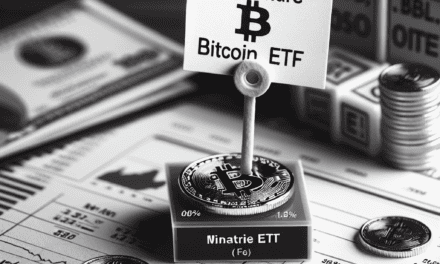“Liquid Restaking Tokens: Breathing New Life into Ethereum DeFi.”
Introduction
Liquid Restaking Tokens (LRTs) represent a transformative innovation within the Ethereum decentralized finance (DeFi) ecosystem, offering a novel approach to enhancing liquidity and capital efficiency. By enabling users to restake their staked assets, LRTs unlock additional layers of utility and flexibility, allowing participants to maximize their yield potential without compromising the security and decentralization of the network. This mechanism revitalizes Ethereum DeFi by providing a seamless integration of staking and liquidity provision, fostering a more dynamic and resilient financial landscape. As LRTs gain traction, they promise to redefine the boundaries of DeFi, driving increased participation and innovation across the Ethereum ecosystem.
Introduction To Liquid Restaking Tokens: A New Era In Ethereum DeFi
The Ethereum ecosystem has long been at the forefront of decentralized finance (DeFi), continuously evolving to meet the demands of its users. As the landscape of DeFi expands, innovative solutions are required to address the challenges of scalability, liquidity, and user engagement. One such innovation is the advent of Liquid Restaking Tokens (LRTs), which promise to usher in a new era in Ethereum DeFi by enhancing the utility and flexibility of staked assets. To understand the significance of LRTs, it is essential to first consider the context in which they have emerged.
Ethereum’s transition to a proof-of-stake (PoS) consensus mechanism has been a pivotal development, allowing users to stake their Ether (ETH) to secure the network and earn rewards. However, traditional staking often involves locking up assets for a specified period, which can limit liquidity and reduce the opportunity for stakers to participate in other DeFi activities. This is where Liquid Restaking Tokens come into play, offering a solution that combines the benefits of staking with the flexibility of liquid assets.
LRTs are essentially tokenized representations of staked assets, enabling users to maintain liquidity while still participating in the staking process. By issuing LRTs, platforms allow stakers to unlock the value of their staked ETH, providing them with a liquid asset that can be freely traded or utilized within the DeFi ecosystem. This innovation not only enhances liquidity but also opens up new avenues for yield generation, as users can deploy their LRTs in various DeFi protocols to earn additional returns.
Moreover, the introduction of LRTs addresses a critical challenge in the DeFi space: capital efficiency. By enabling stakers to access the value of their staked assets without unbonding them, LRTs improve capital utilization and allow for more dynamic asset management. This increased efficiency can lead to greater participation in DeFi markets, as users are no longer constrained by the illiquidity of their staked assets. Consequently, LRTs have the potential to drive significant growth in the Ethereum DeFi ecosystem by attracting more users and capital.
In addition to enhancing liquidity and capital efficiency, LRTs also contribute to the decentralization and security of the Ethereum network. By incentivizing more users to stake their ETH, LRTs help to distribute network control more evenly, reducing the risk of centralization. Furthermore, the increased participation in staking can bolster the network’s security, as a larger pool of staked assets makes it more resilient to potential attacks.
As with any emerging technology, the adoption of LRTs is not without its challenges. Regulatory considerations, smart contract risks, and potential market volatility are all factors that must be carefully managed to ensure the successful integration of LRTs into the DeFi ecosystem. Nevertheless, the potential benefits of LRTs are substantial, and their development represents a significant step forward in the evolution of Ethereum DeFi.
In conclusion, Liquid Restaking Tokens are poised to revolutionize the Ethereum DeFi landscape by providing a solution to the liquidity constraints of traditional staking. By enabling users to unlock the value of their staked assets, LRTs enhance liquidity, improve capital efficiency, and contribute to the decentralization and security of the network. As the Ethereum ecosystem continues to evolve, the adoption of LRTs could play a crucial role in shaping the future of decentralized finance, offering new opportunities for users and driving further innovation in the space.
How Liquid Restaking Tokens Enhance Liquidity In Ethereum Networks
Liquid Restaking Tokens (LRTs) are emerging as a transformative force within the Ethereum decentralized finance (DeFi) ecosystem, offering a novel approach to enhancing liquidity and optimizing capital efficiency. As Ethereum continues to evolve, the need for innovative solutions to address liquidity constraints becomes increasingly apparent. LRTs present a promising avenue by allowing staked assets to be utilized more effectively, thereby revitalizing the Ethereum DeFi landscape.
To understand the significance of LRTs, it is essential to first consider the traditional staking model within Ethereum. Staking involves locking up a certain amount of cryptocurrency to support network operations, such as validating transactions and securing the blockchain. While this process is crucial for maintaining network integrity, it often results in reduced liquidity, as staked assets are typically inaccessible for other uses. This limitation can hinder the fluidity of capital within the DeFi ecosystem, potentially stifling innovation and growth.
Enter Liquid Restaking Tokens, which aim to address this challenge by enabling staked assets to be represented as tradable tokens. These tokens can be freely transferred, traded, or used as collateral within various DeFi protocols, thereby unlocking liquidity that would otherwise remain dormant. By converting staked assets into LRTs, users can continue to earn staking rewards while simultaneously participating in other DeFi activities, such as lending, borrowing, or yield farming. This dual functionality not only enhances liquidity but also maximizes the utility of staked assets, fostering a more dynamic and interconnected financial ecosystem.
Moreover, the introduction of LRTs can lead to increased capital efficiency within the Ethereum network. By allowing staked assets to be actively utilized, LRTs reduce the opportunity cost associated with staking, encouraging more participants to engage in network security without sacrificing liquidity. This increased participation can, in turn, bolster the overall security and resilience of the Ethereum blockchain, as a larger pool of staked assets contributes to a more robust consensus mechanism.
In addition to improving liquidity and capital efficiency, LRTs also offer potential benefits in terms of risk management. By diversifying the use of staked assets across multiple DeFi protocols, users can mitigate the risks associated with concentrating their holdings in a single platform. This diversification can provide a buffer against potential losses, enhancing the overall stability of individual portfolios and the broader DeFi ecosystem.
Furthermore, the adoption of LRTs can stimulate innovation within the Ethereum network by encouraging the development of new financial products and services. As LRTs become more widely integrated into DeFi protocols, developers are likely to explore novel use cases and applications, driving the evolution of the ecosystem. This innovation can lead to the creation of more sophisticated financial instruments, offering users a broader range of options for managing their assets and optimizing returns.
In conclusion, Liquid Restaking Tokens represent a significant advancement in the quest to enhance liquidity within the Ethereum DeFi ecosystem. By unlocking the potential of staked assets, LRTs not only improve capital efficiency but also contribute to a more secure, resilient, and innovative financial landscape. As the Ethereum network continues to grow and evolve, the adoption of LRTs is poised to play a crucial role in shaping the future of decentralized finance, offering new opportunities for users and developers alike.
The Role Of Liquid Restaking Tokens In DeFi Yield Optimization
Liquid Restaking Tokens (LRTs) are emerging as a transformative force within the Ethereum decentralized finance (DeFi) ecosystem, offering innovative solutions for yield optimization. As the DeFi landscape continues to evolve, the need for more efficient and flexible financial instruments becomes increasingly apparent. LRTs address this demand by enabling users to maximize their returns on staked assets while maintaining liquidity, thus revitalizing the Ethereum DeFi space.
To understand the role of LRTs in yield optimization, it is essential to first consider the limitations of traditional staking mechanisms. In conventional staking, users lock their assets in a network to support its operations and, in return, receive rewards. However, this process often results in illiquidity, as staked assets cannot be easily accessed or utilized for other purposes. This lack of flexibility can be a significant drawback for investors seeking to optimize their yield across multiple DeFi platforms.
Enter Liquid Restaking Tokens, which offer a compelling solution to this challenge. By tokenizing staked assets, LRTs provide users with a liquid representation of their staked holdings. This token can then be freely traded or used as collateral in various DeFi protocols, thereby unlocking additional yield opportunities. Consequently, LRTs enable investors to maintain the benefits of staking while simultaneously participating in other yield-generating activities, such as lending, borrowing, or liquidity provision.
Moreover, the integration of LRTs into the DeFi ecosystem enhances capital efficiency. By allowing staked assets to be utilized in multiple ways, LRTs reduce the opportunity cost associated with staking. This increased efficiency not only benefits individual investors but also contributes to the overall liquidity and robustness of the DeFi market. As more users adopt LRTs, the resulting liquidity influx can lead to tighter spreads and improved price discovery across various platforms.
In addition to improving capital efficiency, LRTs also play a crucial role in risk management. By diversifying their yield-generating activities, investors can mitigate the risks associated with relying on a single source of income. This diversification is particularly important in the volatile DeFi landscape, where market conditions can change rapidly. LRTs empower users to adapt to these fluctuations by reallocating their assets as needed, thereby enhancing their ability to manage risk effectively.
Furthermore, the adoption of LRTs can drive innovation within the DeFi space. As developers recognize the potential of these tokens, they are likely to create new protocols and applications that leverage their unique properties. This innovation can lead to the development of more sophisticated financial products, further expanding the range of yield optimization strategies available to investors. In turn, this can attract a broader audience to the DeFi ecosystem, fostering its growth and maturation.
In conclusion, Liquid Restaking Tokens represent a significant advancement in the quest for yield optimization within the Ethereum DeFi ecosystem. By providing liquidity to staked assets, LRTs enable investors to maximize their returns while maintaining flexibility and managing risk. As the DeFi landscape continues to evolve, the adoption of LRTs is poised to play a pivotal role in shaping its future, driving innovation, and enhancing capital efficiency. As such, LRTs are not only revitalizing Ethereum DeFi but also paving the way for a more dynamic and resilient financial ecosystem.
Security Implications Of Liquid Restaking Tokens In Ethereum

Liquid Restaking Tokens (LRTs) have emerged as a transformative innovation within the Ethereum decentralized finance (DeFi) ecosystem, offering new opportunities for liquidity and capital efficiency. However, as with any novel financial instrument, LRTs introduce a range of security implications that warrant careful consideration. Understanding these implications is crucial for stakeholders, including developers, investors, and regulators, as they navigate the evolving landscape of Ethereum DeFi.
At the core of LRTs is the concept of restaking, which allows users to stake their Ethereum assets in multiple protocols simultaneously. This mechanism enhances liquidity by enabling staked assets to be utilized across various DeFi platforms without being locked in a single protocol. While this innovation promises increased capital efficiency and potential returns, it also introduces complexities that could impact the security of the Ethereum network.
One primary security concern associated with LRTs is the increased risk of smart contract vulnerabilities. As LRTs facilitate interactions between multiple protocols, they inherently rely on a complex web of smart contracts. Each additional layer of interaction introduces potential points of failure, where vulnerabilities in one contract could cascade through the network, affecting multiple protocols. This interconnectedness necessitates rigorous auditing and testing of smart contracts to mitigate the risk of exploits that could lead to significant financial losses.
Moreover, the composability of LRTs raises concerns about systemic risk within the Ethereum ecosystem. The ability to restake assets across various platforms creates intricate dependencies between protocols. In the event of a failure or exploit in one protocol, the repercussions could ripple through the network, potentially destabilizing other interconnected platforms. This interconnectedness underscores the importance of robust risk management strategies and contingency plans to address potential systemic threats.
In addition to technical vulnerabilities, LRTs also pose challenges related to governance and regulatory compliance. The decentralized nature of Ethereum DeFi means that governance decisions are often made by decentralized autonomous organizations (DAOs) or through community voting. The introduction of LRTs could complicate governance processes, as stakeholders must consider the implications of restaking on protocol security and stability. Furthermore, regulators may scrutinize LRTs to ensure compliance with existing financial regulations, particularly concerning issues such as anti-money laundering (AML) and know-your-customer (KYC) requirements.
To address these security implications, stakeholders in the Ethereum DeFi ecosystem must prioritize collaboration and transparency. Developers should engage in open dialogue with security experts and auditors to identify and address potential vulnerabilities in LRT-related smart contracts. Additionally, fostering a culture of transparency and information sharing can help build trust among users and investors, ensuring that they are aware of the risks and benefits associated with LRTs.
Furthermore, the development of standardized security frameworks and best practices for LRTs could enhance the overall resilience of the Ethereum DeFi ecosystem. By establishing guidelines for smart contract auditing, risk management, and governance, stakeholders can work towards creating a more secure and sustainable environment for the adoption of LRTs.
In conclusion, while Liquid Restaking Tokens offer promising opportunities for enhancing liquidity and capital efficiency within Ethereum DeFi, they also introduce a range of security implications that must be carefully managed. By addressing smart contract vulnerabilities, systemic risks, and governance challenges, stakeholders can harness the potential of LRTs while safeguarding the integrity and stability of the Ethereum network. As the DeFi landscape continues to evolve, proactive measures and collaborative efforts will be essential in ensuring the secure and sustainable growth of this innovative financial ecosystem.
Comparing Liquid Restaking Tokens With Traditional Staking Methods
Liquid Restaking Tokens (LRTs) are emerging as a transformative force within the Ethereum decentralized finance (DeFi) ecosystem, offering a novel approach to staking that contrasts sharply with traditional methods. To understand the significance of LRTs, it is essential to first consider the conventional staking mechanisms that have long been a staple in the blockchain world. Traditional staking involves locking up a certain amount of cryptocurrency in a network to support its operations, such as validating transactions and securing the network. In return, stakers earn rewards, typically in the form of additional tokens. However, this method often requires participants to commit their assets for a fixed period, during which they cannot access or utilize them for other purposes.
In contrast, Liquid Restaking Tokens introduce a new level of flexibility and utility to the staking process. By allowing stakers to receive a tokenized representation of their staked assets, LRTs enable users to maintain liquidity while still participating in network validation. This innovation effectively bridges the gap between staking and liquidity, providing users with the ability to engage in other DeFi activities without sacrificing their staking rewards. As a result, LRTs are poised to enhance the overall efficiency and attractiveness of the Ethereum DeFi landscape.
One of the primary advantages of LRTs over traditional staking is the increased liquidity they offer. In traditional staking, assets are often locked up for extended periods, which can be a significant drawback for users who wish to remain agile in their investment strategies. With LRTs, however, users can freely trade or utilize their tokenized staked assets across various DeFi platforms, thereby unlocking new opportunities for yield generation and risk management. This added liquidity not only benefits individual stakers but also contributes to the overall dynamism and resilience of the DeFi ecosystem.
Moreover, LRTs introduce a layer of composability that is absent in traditional staking methods. Composability, a key feature of DeFi, refers to the ability of different financial protocols and instruments to interact seamlessly with one another. By tokenizing staked assets, LRTs can be integrated into a wide array of DeFi applications, such as lending platforms, decentralized exchanges, and yield farming protocols. This interoperability allows users to maximize the utility of their assets, creating a more interconnected and efficient financial system.
Despite these advantages, it is important to acknowledge the potential risks associated with LRTs. The tokenization of staked assets introduces additional layers of complexity and potential vulnerabilities, such as smart contract risks and liquidity constraints during market downturns. As with any financial innovation, it is crucial for participants to conduct thorough due diligence and risk assessment before engaging with LRTs.
In conclusion, Liquid Restaking Tokens represent a significant evolution in the realm of Ethereum staking, offering a compelling alternative to traditional methods. By providing enhanced liquidity, composability, and utility, LRTs have the potential to revitalize the Ethereum DeFi ecosystem, attracting a broader range of participants and fostering greater innovation. As the DeFi landscape continues to evolve, the adoption and refinement of LRTs will likely play a pivotal role in shaping the future of decentralized finance, offering new possibilities for both individual users and the broader financial system.
The Impact Of Liquid Restaking Tokens On Ethereum’s Scalability
Liquid Restaking Tokens (LRTs) have emerged as a transformative force within the Ethereum ecosystem, particularly in the realm of decentralized finance (DeFi). As Ethereum continues to grapple with scalability challenges, LRTs offer a promising solution that could significantly enhance the network’s efficiency and capacity. To understand the impact of LRTs on Ethereum’s scalability, it is essential to first explore the underlying mechanics of these tokens and their role in the broader DeFi landscape.
At their core, Liquid Restaking Tokens are designed to optimize the staking process on Ethereum. Traditionally, staking involves locking up a certain amount of cryptocurrency to support network operations, such as validating transactions and securing the blockchain. In return, stakers earn rewards. However, this process can be capital-intensive and limits the liquidity of the staked assets. LRTs address this limitation by allowing stakers to tokenize their staked assets, thereby unlocking liquidity without compromising the security and functionality of the staking process.
The introduction of LRTs has profound implications for Ethereum’s scalability. By enabling stakers to maintain liquidity, LRTs encourage more participants to engage in staking, thereby increasing the overall security and decentralization of the network. This increased participation can lead to a more robust and resilient Ethereum blockchain, capable of handling a higher volume of transactions. Moreover, the liquidity provided by LRTs can be redirected into other DeFi protocols, fostering a more dynamic and interconnected financial ecosystem.
Furthermore, LRTs contribute to Ethereum’s scalability by facilitating more efficient use of network resources. As stakers can now access the liquidity of their staked assets, they are more likely to reinvest these assets into other DeFi projects, promoting innovation and growth within the ecosystem. This reinvestment can lead to the development of new scaling solutions, such as layer-2 protocols, which can further alleviate congestion on the Ethereum network. In this way, LRTs not only enhance the immediate scalability of Ethereum but also catalyze long-term improvements in network efficiency.
In addition to these direct benefits, LRTs also play a crucial role in mitigating some of the economic challenges associated with Ethereum’s scalability. By providing liquidity to stakers, LRTs reduce the opportunity cost of staking, making it a more attractive option for a broader range of participants. This democratization of staking can lead to a more equitable distribution of rewards and a more inclusive DeFi ecosystem. As a result, Ethereum can achieve greater scalability without sacrificing its core principles of decentralization and inclusivity.
Moreover, the impact of LRTs on Ethereum’s scalability extends beyond the technical and economic realms. By fostering a more liquid and interconnected DeFi ecosystem, LRTs can enhance the overall user experience on Ethereum. With more efficient and accessible financial services, users are more likely to engage with the network, driving further adoption and growth. This increased user engagement can, in turn, incentivize developers to create more innovative solutions to Ethereum’s scalability challenges, creating a virtuous cycle of improvement and expansion.
In conclusion, Liquid Restaking Tokens represent a significant advancement in the quest to enhance Ethereum’s scalability. By unlocking liquidity, promoting network participation, and fostering innovation, LRTs have the potential to transform the Ethereum ecosystem and pave the way for a more scalable and efficient blockchain. As the DeFi landscape continues to evolve, the role of LRTs in revitalizing Ethereum’s scalability will undoubtedly become increasingly important, offering new opportunities for growth and development within the network.
Future Prospects Of Liquid Restaking Tokens In The DeFi Ecosystem
The decentralized finance (DeFi) ecosystem has witnessed remarkable growth and innovation over the past few years, with Ethereum at its core. As the landscape continues to evolve, new financial instruments and mechanisms are emerging to enhance the efficiency and utility of digital assets. Among these innovations, Liquid Restaking Tokens (LRTs) have garnered significant attention for their potential to revitalize Ethereum’s DeFi ecosystem. By offering a novel approach to staking and liquidity provision, LRTs are poised to address some of the existing challenges while unlocking new opportunities for users and developers alike.
To understand the future prospects of Liquid Restaking Tokens, it is essential to first grasp their fundamental concept. LRTs are essentially derivative tokens that represent staked assets, allowing users to maintain liquidity while participating in network security and consensus. This dual functionality is achieved by enabling users to stake their assets in a proof-of-stake (PoS) network, such as Ethereum 2.0, and receive LRTs in return. These tokens can then be utilized within the DeFi ecosystem, providing liquidity, earning yield, or even being traded on secondary markets. Consequently, LRTs offer a compelling solution to the liquidity constraints traditionally associated with staking.
The introduction of LRTs into the DeFi ecosystem holds several promising implications. Firstly, they have the potential to significantly enhance capital efficiency. By allowing staked assets to remain liquid, LRTs enable users to maximize the utility of their holdings. This increased liquidity can lead to more dynamic and efficient markets, as users are no longer forced to choose between staking and participating in DeFi activities. Moreover, the ability to leverage staked assets in various DeFi protocols can amplify yield generation, attracting more participants to the ecosystem and fostering greater innovation.
In addition to improving capital efficiency, LRTs can also contribute to the decentralization and security of PoS networks. By incentivizing more users to stake their assets, LRTs can help distribute network control more evenly, reducing the risk of centralization. This broader participation not only strengthens the network’s security but also aligns with the ethos of decentralization that underpins the blockchain space. Furthermore, as LRTs gain traction, they may encourage the development of new staking strategies and products, further enriching the DeFi landscape.
However, the integration of Liquid Restaking Tokens into the DeFi ecosystem is not without challenges. One of the primary concerns is the potential for increased complexity and risk. As LRTs introduce additional layers of abstraction and financial engineering, users must navigate a more intricate landscape, which may deter less experienced participants. Additionally, the reliance on smart contracts to facilitate LRT functionality introduces potential vulnerabilities, necessitating robust security measures and thorough audits to mitigate risks.
Despite these challenges, the future prospects of Liquid Restaking Tokens in the DeFi ecosystem remain promising. As the technology matures and user education improves, LRTs are likely to become an integral component of Ethereum’s DeFi infrastructure. By enhancing liquidity, capital efficiency, and network security, LRTs have the potential to drive further growth and innovation in the space. As developers continue to explore and refine this concept, the broader DeFi community stands to benefit from the increased flexibility and opportunities that LRTs offer. In conclusion, Liquid Restaking Tokens represent a significant step forward in the evolution of decentralized finance, with the potential to reshape the landscape and unlock new possibilities for users and developers alike.
Q&A
1. **What are Liquid Restaking Tokens (LRTs)?**
Liquid Restaking Tokens (LRTs) are a new class of tokens that represent staked assets in Ethereum’s DeFi ecosystem, allowing users to earn additional yield by participating in multiple staking opportunities simultaneously.
2. **How do LRTs work?**
LRTs work by tokenizing staked assets, enabling them to be used in other DeFi protocols while still earning staking rewards. This is achieved through smart contracts that manage the staking and restaking processes.
3. **What is the primary benefit of LRTs?**
The primary benefit of LRTs is the ability to maximize yield by allowing staked assets to be utilized in various DeFi applications, thereby increasing capital efficiency and liquidity.
4. **How do LRTs impact Ethereum’s DeFi ecosystem?**
LRTs enhance Ethereum’s DeFi ecosystem by providing more liquidity and flexibility, encouraging greater participation in staking, and enabling more complex financial strategies.
5. **What are the risks associated with LRTs?**
Risks include smart contract vulnerabilities, potential for over-leveraging, and liquidity risks if the underlying staked assets experience significant volatility or if there is a sudden demand for withdrawals.
6. **How do LRTs differ from traditional staking?**
Unlike traditional staking, where assets are locked and cannot be used elsewhere, LRTs allow staked assets to remain liquid and be used across multiple DeFi platforms, thus offering more versatility and potential returns.
7. **What role do LRTs play in revitalizing Ethereum DeFi?**
LRTs play a crucial role in revitalizing Ethereum DeFi by increasing the utility and efficiency of staked assets, attracting more users to participate in staking, and fostering innovation in financial products and services.
Conclusion
Liquid Restaking Tokens (LRTs) represent a significant innovation in the Ethereum DeFi ecosystem, offering enhanced flexibility and capital efficiency. By allowing staked assets to be utilized in multiple DeFi protocols simultaneously, LRTs unlock additional liquidity and enable users to maximize their yield opportunities without compromising network security. This revitalization of Ethereum DeFi through LRTs not only attracts more participants to the staking process but also fosters a more dynamic and interconnected financial ecosystem. As LRTs continue to evolve, they have the potential to drive further growth and innovation within the Ethereum network, solidifying its position as a leading platform for decentralized finance.





